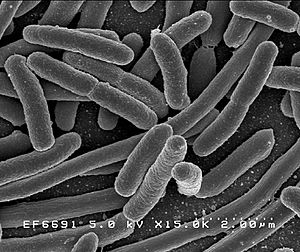Gut flora facts for kids

Your gut flora (also called gut microbiota) is a huge group of tiny living things, mostly bacteria, that live inside your digestive system. Think of your body as a big house, and these tiny microbes are like helpful tenants living in a special part of it – your gut! They are the largest collection of microbes in your whole body.
Your body has about 100 trillion cells. But guess what? You carry about ten times more microorganisms in your intestines than you have cells in your body! These tiny helpers do so many important jobs that some people even call your gut flora a 'forgotten organ'. It's like a hidden organ working hard for you. These gut microbes also have way more genes than you do, about 100 times more!
Most of these tiny living things are bacteria, especially in your large intestine. They even make up a big part of what's in your poop! Scientists think there are between 300 and 1000 different kinds, or species, of microbes living in your gut. But most of the bacteria (about 99%) come from just 30 or 40 main species. There are also some fungi and other tiny creatures called protozoa in your gut, but we don't know as much about what they do.
Contents
Your Gut's Tiny Helpers
Scientists used to think that these microbes just lived in your gut without really helping or hurting you. This is called commensalism. But now, we know it's a much closer relationship, called a symbiotic relationship. This means both you and the microbes benefit from each other!
Even though people can live without gut flora, these tiny organisms do many amazing things for you:
- They help break down food parts your body can't use on its own, turning them into energy.
- They help train your immune system, which is your body's defense team against sickness.
- They stop harmful bacteria from growing and making you sick.
- They help your gut develop properly.
- They make important vitamins for you, like biotin and vitamin K.
- They can even produce hormones that tell your body to store fats.
However, sometimes, if there's an imbalance, some types of these microbes can cause problems. They might lead to an infection or increase the risk of certain diseases.
Food for Good Bacteria
What you eat can really affect your gut flora! Certain food parts, like polyphenols (found in fruits and veggies), oligosaccharides, and polysaccharides (types of complex sugars), are great food for the good bacteria in your gut. Eating these can help the good bacteria grow and reduce the number of harmful ones.
Oxygen Levels in the Gut
Most of the bacteria in your gut (over 99%) are anaerobic. This means they don't need oxygen to live. They actually prefer places without much oxygen! But in a part of your large intestine called the cecum, there are also many aerobic bacteria, which do need oxygen.
Breaking Down Tough Stuff
Did you know that some animals, like cows or sheep, eat a lot of plants? Plants contain a very common and tough material called cellulose. For a long time, scientists thought that animals couldn't break down cellulose by themselves. Instead, they relied on special microbes in their gut to make an enzyme called cellulase, which does the job. Cellulose is super common – it makes up about a third of all plant matter on Earth! For example, cotton is almost all cellulose. Recently, some new information suggests that a few animals might actually make their own cellulase. But it's still something scientists are studying!
Related pages
Images for kids
-
Candida albicans, a type of fungus that can live in the gut
See also
 In Spanish: Microbiota intestinal para niños
In Spanish: Microbiota intestinal para niños



